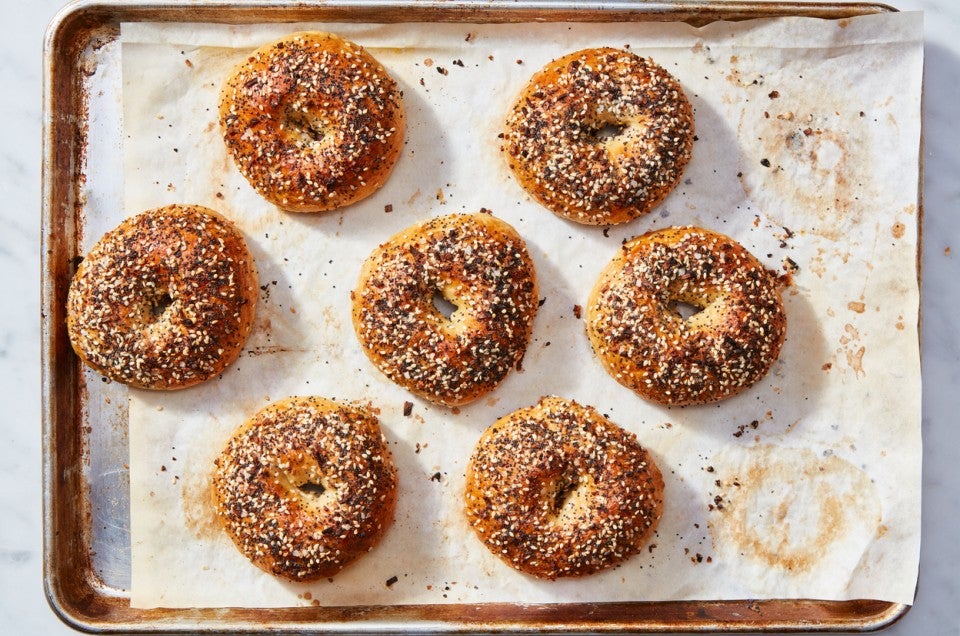What's the difference between diastatic and non-diastatic malt?
How to use different malts for better flavor, color, and rise in your bagels and breads.


 The bakers of King Arthur are here to solve the kitchen conundrums you share with us, whether it’s on the phone, computer, or by the good old postal service. In Ask the Baker’s Hotline, Annabelle will pick the brains of the talented King Arthur Baker’s Hotline team to tackle some of your most-asked questions.
The bakers of King Arthur are here to solve the kitchen conundrums you share with us, whether it’s on the phone, computer, or by the good old postal service. In Ask the Baker’s Hotline, Annabelle will pick the brains of the talented King Arthur Baker’s Hotline team to tackle some of your most-asked questions.
* * *
Our Recipe of the Year, Ultimate Sandwich Bagels, calls for a potentially head-scratching ingredient: barley malt syrup. To many, the term “malt” is associated with a frothy malted milkshake or a single-malt whisky. To a baker, though, malt can play a huge role in the color, flavor, and rise of baked goods. So what is malt? What does it do? What’s the difference between “malt” products like diastatic malt, non-diastatic malt, and the aforementioned barley malt syrup?
Lucky for us, Alexander of our Baker’s Hotline is here to set things straight!
Malt is a product of barley. If it’s being made into a powder, like diastatic or non-diastatic malt powder, the grains are sprouted, dried, and ground up. If it’s becoming a syrup, the barley is cooked and reduced. And remember, “Since barley naturally contains gluten, malt products are not gluten-free,” says Alexander.

Malt ingredients are used in yeast breads to enhance color, improve flavor, and in some cases, aid in rising. One of the places malt really shines is in bagel recipes. Enter Ultimate Sandwich Bagels. While you can use a variety of alternatives, “For traditionalists, there is only one ingredient worthy for bagels: malt,” says Alexander. “Malt is what gives a bagel its earthy sweetness and amber color."
Here's a breakdown of the three malt products most frequently used in baking and how to substitute for each other:
A syrupy mixture of barley and other cereal grains
The easiest of the three products to find in grocery stores
Often added to bagels’ boiling solution to create an amber, shiny crust
Helps achieve that signature "bagel-y" flavor
Substitute: For bagels, try brown sugar or non-diastatic malt powder in the dough and honey in the boiling solution (equal parts by weight). Or, you could use 0.8 gram diastatic malt powder for every 1 gram barley malt syrup in the dough. If you use diastatic malt powder, keep an eye on the dough, as it may rise faster than the recipe suggests.
If you’re concerned about changing the hydration of your dough by replacing the syrup with dry brown sugar, Alexander has your back: “Because the syrup is so viscous and such a small amount is used in a dough, the hydration of your dough will not change in any significant way.”

A powder made from ground malted barley in which a naturally occurring enzyme is still intact
Boosts yeast activity (thanks to the enzyme, which breaks down flour starch into sugars for the yeast to eat) resulting in a faster rise
Adds sweetness and darker color to your bakes
Commonly added to all-purpose and bread flours (such as King Arthur flour) to give your baked goods a better rise, color, and flavor
Substitute: An equal portion of non-diastatic malt powder (by volume or weight), but expect a longer rise
Alexander shared a tidbit of advice from the author of Bread, Jeffrey Hamelman. If you’re thinking of adding diastatic malt to a bread or bagel recipe that doesn't originally call for it, keep this in mind: “Too much diastatic malt powder can produce a gummy and unappealing product, so it’s best to start with around 0.1 to 0.2% of the flour's weight and work up from there in small increments.”

A powder similar to diastatic, but the naturally occurring enzyme is not active, so it won’t aid in rising
Adds sweetness and darker color to your bakes
Often added to yeast bread recipes (like our New England Hot Dog Buns) in place of sugar, purely for flavor
Substitute: An equal portion of barley malt syrup or diastatic malt powder by volume, but beware …
Remember Jeffrey’s advice above? In many recipes, you can’t simply swap in diastatic malt powder in place of non-diastatic, as it could lead to a gummy texture. “I recommend sticking with barley malt syrup, or toasting the diastatic malt powder at 350°F for 5 minutes to deactivate the enzyme,” shares Alexander.
There’s one more commonly known malt out there: malted milk powder. Despite the name, this isn’t in the same category as everything we’ve covered. While it’s made from barley malt, it’s primarily used as a flavored sweetener, not a baking aide.
Non-diastatic malt powder and barley malt syrup will boost the sweetness and color of your baked goods.
Diastatic malt powder will do all of that, plus your dough will rise faster. If you’re adding it to a recipe that doesn’t originally call for it, the recommended quantity is around 0.2% of the flour's weight.
If you’re ready to make a batch of bagels and wondering which type of malt to go for, we find that barley malt syrup imparts the best color and flavor. Beyond that, most recipes will call for the best malt option in their ingredient list.
Got a question you'd like answered? Drop it in the comments below, and I’ll see you next time with more baking insights from the King Arthur Baker’s Hotline!
Cover photo by Rick Holbrook.

